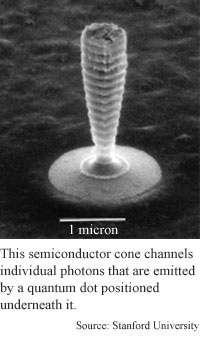
Light source brightens prospects for security
By Eric Smalley, Technology Research NewsIn order to send a perfectly secure message, the light pulses that make up the communications signal must contain one and only one photon each. But there's no way to reliably generate one photon per pulse using ordinary light sources.
Although two teams of researchers recently came up with devices that generate one photon per pulse, neither is particularly efficient at sending those single-photon pulses in a chosen direction. (TRN January 3/10, 2001)
Researchers at Stanford University have taken the research a step further with a single-photon light source that uses a microscopic cone to direct the photons. If the photons' path can be controlled, the light source can be more easily integrated with other optical equipment like communications devices, sensors and quantum computers.
"This new light source... improves both security and the information rate of quantum key distribution systems," said Yoshihisa Yamamoto, a professor of applied physics and electrical engineering at Stanford University.
The device consists of a single quantum dot embedded in a semiconductor wafer with a semiconductor cone mounted vertically above the quantum dot. The hollow cone, or vertical cavity, is about one and a half microns tall, and 150 nanometers in diameter at the bottom and 500 nanometers at the top. Vertical cavities channel photons and are widely used to direct semiconductor lasers.
The device's efficiency for channeling photons in a particular direction is 78 percent, said Yamamoto.
The Stanford quantum dot device is similar to a single photon emitter developed at the University of California at Santa Barbara. The principal difference is the UC Santa Barbara device uses a semiconductor disk rather than a vertical cavity structure. "The difference is basically how to extract those single photons out of the quantum dot efficiently," said Yamamoto.
The Stanford device can be coupled to other optical systems more efficiently, while the UC Santa Barbara device produces photons that survive longer, he said.
A practical, realistic single photon source could be built within the few years, said Yamamoto.
Yamamoto's research colleagues were Charles Santori, Matthew Pelton, Glenn Solomon and Yseulte Dale. They published their work on the single-photon quantum dot light source in the February 19, 2001 issue of Physical Review Letters. The research on the vertical cavity post has not been published. The research was funded by the Japan Science and Technology Corp., the National Science Foundation, and Stanford University.
Timeline: <3 years
Funding: Government, University
TRN Categories: Semiconductors and Materials; Quantum Computing
Story Type: News
Related Elements: Technical paper, "Triggered Single Photons from a Quantum Dot," Physical Review Letters, February 19, 2001
Advertisements:
February 28, 2001
Page One
Robots learn soft touch
Evolution breeds cooperation
Chip promises brighter wearable displays
Light source brightens prospects for security
Bound bits could bring bigger disks

News:
Research News Roundup
Research Watch blog
Features:
View from the High Ground Q&A
How It Works
RSS Feeds:
News
Ad links:
Buy an ad link
| Advertisements:
|
 |
Ad links: Clear History
Buy an ad link
|
TRN
Newswire and Headline Feeds for Web sites
|
© Copyright Technology Research News, LLC 2000-2006. All rights reserved.